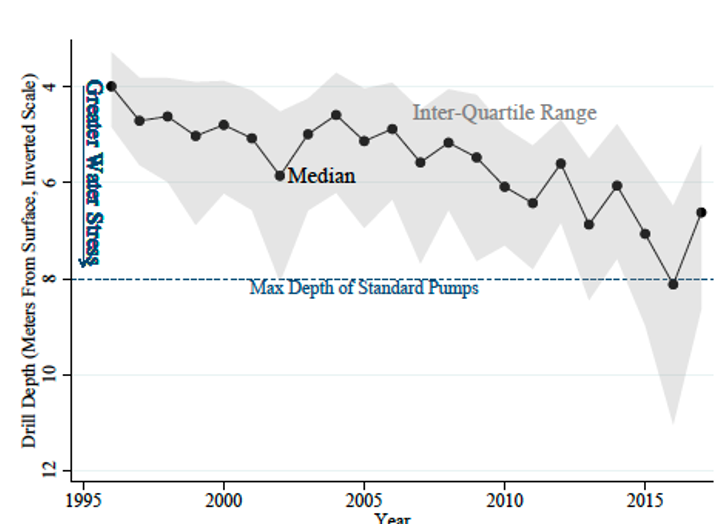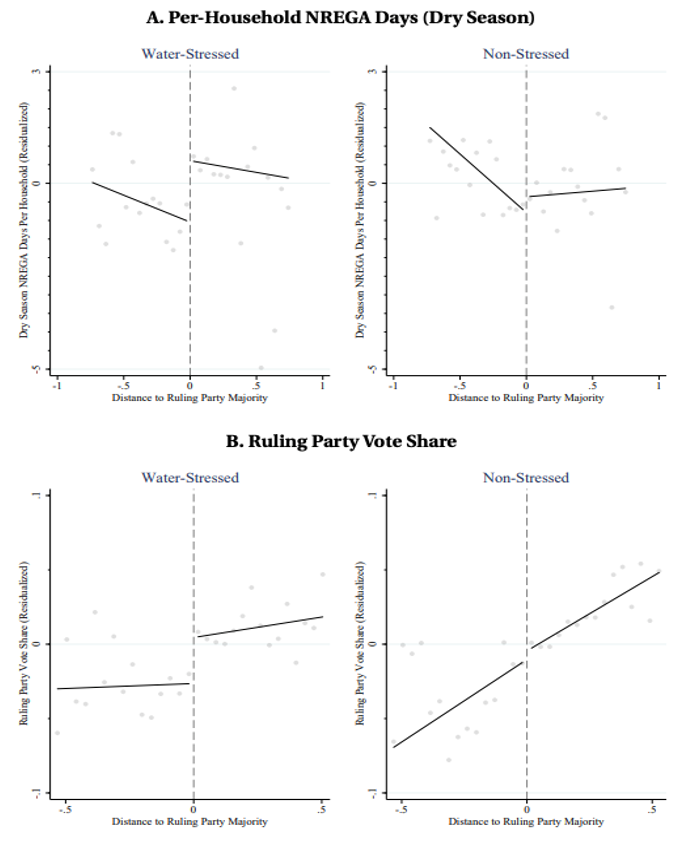
Falling groundwater levels in India have enabled politicians to manipulate aid for electoral gain
Accountability is a bedrock of democracy. In times of crisis, an active electorate rewards leaders who provide timely disaster relief (Besley and Burgess 2002). All too often, however, the distribution of crisis relief becomes a tool for winning elections. Extensive research based in India has found that politicians will sometimes give prospective voters selective access to services (Cole 2009, Mahadevan 2021, Asher and Novosad 2017). Other work shows that aid may be sent to regions to maximise political gains rather than alleviate genuine need (Tarquinio 2021). The timing of aid disbursement is also not immune to manipulation, with a strategic surge occurring just before elections (Cole et al. 2012).
Yet the ramifications extend beyond opportunistic tactics. There is a deeper risk that a sustained crisis may serve as a tool for entrenching political power, leaving no incentive to fix it. Wade's (1982) case study of unkempt and dysfunctional canals in South India shows how a clientelistic bureaucracy can exploit chronic disrepair to extract bribes. Neither bureaucrats nor the politicians who nominally oversee them have any incentive to fix the canals. Doing so would cost them a lucrative source of income.
Recent research has revealed a troubling connection between climate change, exploitative practices, and the availability of affordable electricity for irrigation, leading to a rapid decline in water levels worldwide (Asoka et al. 2017, Wu et al. 2020, van der Gun 2012). These drier conditions pose significant challenges, particularly for rural societies, as they can exacerbate poverty and inequality (Sekhri 2014). As a result, rural households often become heavily reliant on government-controlled programmes to cope. Politicians may choose to either address underlying challenges or use targeted aid at their disposal to advance their interests. Developing countries face a heightened risk because they not only bear the brunt of climate change and resource shortages but may also lack the institutional safeguards necessary to prevent such political misappropriation (Burgess et al. 2017, 2014, Carleton et al. 2020).
Are such historical anecdotes indicative of a pervasive tendency for politicians to exploit crises for electoral gain? Mahadevan and Shenoy (2023) aim to study this question in the context of increasingly dry conditions in India. This research seeks to discern the extent to which falling groundwater levels can become fertile ground for the manipulation of aid and the consolidation of political power.
The context
This study investigates whether the ruling party of West Bengal, India, strategically exploited groundwater depletion and its control over a major anti-poverty programme to win votes. West Bengal, like many Indian states, has experienced a significant decline in its water table (see Figure 1). Groundwater is often inaccessible without costly drilling technology, making it hard for many farmers to grow crops during the dry season. They rely instead on jobs provided through the National Rural Employment Guarantee Act (NREGA), a public works programme. Although the central government funds NREGA, state governments have considerable influence over the allocation of funds to village governments (gram panchayats). These panchayats then choose which households receive employment under the programme (Government of India 2013). NREGA is a major tool in the hands of village politicians, accounting for over 80% of the funds under their control (Dey and Sen 2016).
Figure 1: Water tables in West Bengal have been steadily declining

Our study examines whether the ruling party disproportionately allocates funds and secures a greater share of votes in water-stressed areas under the control of its co-partisans. We study NREGA allocations in the aftermath of the 2013 village council elections. We compare allocations to village councils where the party of the state government barely won a majority to those where it narrowly did not. Since the characteristics of villages and their elected officials are, on average, similar in these two groups, any differences in aid disbursement must be caused by the difference in political alignment.
Evidence of strategic targeting by politicians
The paper finds that NREGA aid flows heavily to regions that are water stressed. This is to be expected, and may, on the surface, appear to be an example of a well-functioning democracy. But within water-stressed areas, panchayats aligned with the state’s ruling party receive disproportionately large allocations of aid. Equally stressed regions under the control of other parties receive considerably less. Households in ruling party-controlled panchayats receive approximately 13% more NREGA days than those in panchayats not controlled by the ruling party, with almost all of these differences driven by water-stressed regions.
What do state politicians gain by selectively targeting their co-partisans?
Many regional political parties have national aspirations and are active in national coalitions. The selective targeting of aid pays off in the subsequent national election in 2014, especially in water-stressed areas. Areas with village councils that were co-partisan to the ruling party, which received a disproportional amount of aid before the national election, also registered a disproportionately high vote share for the ruling party. This pattern is visualised in Figure 2, where there are discrete jumps in aid allocation and subsequent national vote share in water-stressed regions controlled by the ruling party.
Figure 2: Discontinuities in aid allocation, and subsequent vote shares in water-stressed regions

One possible concern revolves around the perceived favouritism towards AITC-controlled (ruling-party-controlled) panchayats. One could argue that this preference is not a result of targeted spending or clientelism but rather due to co-partisan efficiencies. According to this hypothesis, AITC councils may more successfully secure NREGA projects' approvals through state government pressure for administrative tasks or informal connections between local and state officials belonging to the same party. To investigate this concern, we examine NREGA job allocation within villages of AITC-controlled panchayats. Given that all panchayat villages have the same council, there should theoretically be no differences in allocation arising from co-partisan efficiencies. The analysis reveals that even within panchayats, villages supporting the AITC in previous elections received more jobs. Additionally, there are indications that this discrepancy is more pronounced in water-stressed regions, although not statistically significant. While co-partisan efficiencies may contribute partially to these targeting differences, they are unlikely to be the sole explanation for the observed results.
Implications
These patterns of favouritism are unlikely to be limited to differences in access to water. Poverty arising from any cause creates opportunities for political targeting. However, the example of water scarcity presents a unique and arguably more worrying trend because it is likely to worsen without intervention. Even as rising productivity reduces the size of the urban poor, the steadily eroding environment may create a growing pool of rural poor who are desperate for aid and, thus, in the power of those who control it.
References
Asher, S and P Novosad (2017), “Politics and Local Economic Growth: Evidence from India,” American Economic Journal: Applied Economics, 9(1): 229–273.
Besley, T and R Burgess (2002), “The Political Economy of Government Responsiveness: Theory and Evidence from India,” Quarterly Journal of Economics, 117(4): 1415–1451.
Burgess, R, O Deschenes, D Donaldson, and M Greenstone (2014), “The Unequal Effects of Weather and Climate Change: Evidence from Mortality in India,” Working Paper, MIT.
Burgess, R, O Deschenes, D Donaldson, and M Greenstone (2017), “Weather, Climate Change and Death in India,” Working Paper, London School of Economics.
Carleton, T A, A Jina, M T Delgado, M Greenstone, T Houser, S M Hsiang, A Hultgren, R E Kopp, K E McCusker, I B Nath, J Rising, A Rode, H K Seo, J Y A Viaene, and A T Zhang (2020), “Valuing the Global Mortality Consequences of Climate Change Accounting for Adaptation Costs and Benefits,” NBER Working Paper 27599.
Cole, S (2009), “Fixing Market Failures or Fixing Elections? Agricultural Credit in India,” American Economic Journal: Applied Economics, 1(1): 219–250.
Dey, S and K Sen (2016), “Is Partisan Alignment Electorally Rewarding? Evidence from Village Council Elections in India,” IZA Discussion Paper No. 9994.
Government of India, “Mahatma Gandhi National Rural Employment Guarantee Act, 2005 Operational Guidelines,” Technical Report, Ministry of Rural Development 2013.
Mahadevan, M (2023), “The Price of Power: Costs of Political Corruption in Indian Electricity,” Working Paper.
Mahadevan, M and A Shenoy (2023), “The Political Consequences of Resource Scarcity: Targeted Spending in a Water-stressed Democracy”, Journal of Public Economics: 220.
Tarquinio, L (2021), “The Politics of Drought Relief: Evidence from Southern India,” IED Working Paper No. 354.
Wade, R (1982), “The system of administrative and political corruption: Canal irrigation in South India,” The Journal of Development Studies, 18(3): 287–328.
Asoka, A, T Gleeson, Y Wada, and V Mishra (2017), “Relative Contribution of Monsoon Precipitation and Pumping to Changes in Groundwater Storage in India,” Nature Geoscience, 10(2): 109–117.
Sekhri, S (2014), “Wells, Water, and Welfare: The Impact of Access to Groundwater on Rural Poverty and Conflict,” American Economic Journal: Applied Economics, 6(3): 76-102.
Shenoy, A and L Zimmermann (2022), “Political Organizations and Political Scope,” Working Paper.
van der Gun, J (2012), “Groundwater and Global Change:Trends, Opportunities and Challenges,” United Nations Educational, Scientific and Cultural Organization.
Wu, W-Y, M-H Lo, Y Wada, J S Famiglietti, J T Reager, P J-F Yeh, A Ducharne, and Z-L Yang (2020), “Divergent Effects of Climate Change on Future Groundwater Availability in Key Mid-latitude Aquifers,” Nature Communications, 11(1): 3710.


